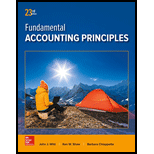
Concept explainers
Accounts Receivable:
The accounts receivable depicts the amount to be realized from the customers to whom the goods have been sold on credit by the business. Accounts receivable is an asset for the company as its collection increases the value of cash or amounts in bank and ultimately increases the assets part of the
Direct Write-off Method of Accounting:
In direct write-off method the bad debts are charged to expenses being incurred during the period in which specific invoices were distinctly regarded as bad debts. Also, under this method the recorded sales are not reduced but only the bad debts expenses are increased. This method is viable only for the values being written off which do not affect the books of accounts integrally since adopting such method will not bring about any change in the financial statements of the company and ultimately will not help the end-users in analyzing it and neither in decision-making on the basis of financial statements.
Also, another possible avenue in this case is to create a specific provision for bad debts for the period and account for the bad debts against the revenues earned during the period.
To explain: Method utilized in accounting for accounts receivable and realizable value of receivable accounts in the balance sheet of G Company.
Want to see the full answer?
Check out a sample textbook solution
Chapter 9 Solutions
Fundamental Accounting Principles
- Please show me the correct way to solve this financial accounting problem with accurate methods.arrow_forwardWhat is the operating cash flow?arrow_forwardAlpine Manufacturing Company's high and low level of activity last year was 62,000 units of product produced in July and 24,000 units produced in December. Machine maintenance costs were $186,500 in July and $89,300 in December. Using the high-low method, determine an estimate of total maintenance cost for a month in which production is expected to be 40,000 units.arrow_forward
- Summer Tyme, Inc., is considering a new 4-year expansion project that requires an initial fixed asset investment of $2,808 million. The fixed asset will be depreciated straight-line to zero over its 4-year tax life, after which time it will be worthless. The project is estimated to generate $2,496,000 in annual sales, with total costs of $998,400. Required: If the tax rate is 35 percent, what is the operating cash flow (OCF) for this project?arrow_forwardGiven step by step explanation for general accounting question with 100% correct solutionarrow_forwardI am trying to find the accurate solution to this general accounting problem with appropriate explanations.arrow_forward

 AccountingAccountingISBN:9781337272094Author:WARREN, Carl S., Reeve, James M., Duchac, Jonathan E.Publisher:Cengage Learning,
AccountingAccountingISBN:9781337272094Author:WARREN, Carl S., Reeve, James M., Duchac, Jonathan E.Publisher:Cengage Learning, Accounting Information SystemsAccountingISBN:9781337619202Author:Hall, James A.Publisher:Cengage Learning,
Accounting Information SystemsAccountingISBN:9781337619202Author:Hall, James A.Publisher:Cengage Learning, Horngren's Cost Accounting: A Managerial Emphasis...AccountingISBN:9780134475585Author:Srikant M. Datar, Madhav V. RajanPublisher:PEARSON
Horngren's Cost Accounting: A Managerial Emphasis...AccountingISBN:9780134475585Author:Srikant M. Datar, Madhav V. RajanPublisher:PEARSON Intermediate AccountingAccountingISBN:9781259722660Author:J. David Spiceland, Mark W. Nelson, Wayne M ThomasPublisher:McGraw-Hill Education
Intermediate AccountingAccountingISBN:9781259722660Author:J. David Spiceland, Mark W. Nelson, Wayne M ThomasPublisher:McGraw-Hill Education Financial and Managerial AccountingAccountingISBN:9781259726705Author:John J Wild, Ken W. Shaw, Barbara Chiappetta Fundamental Accounting PrinciplesPublisher:McGraw-Hill Education
Financial and Managerial AccountingAccountingISBN:9781259726705Author:John J Wild, Ken W. Shaw, Barbara Chiappetta Fundamental Accounting PrinciplesPublisher:McGraw-Hill Education





